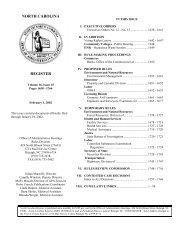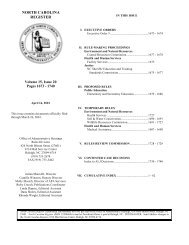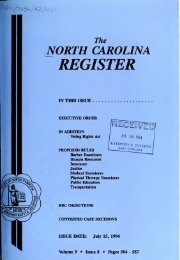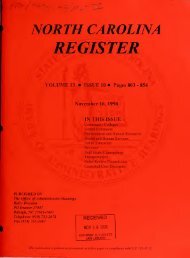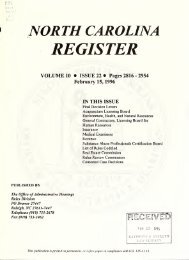NC Register Volume 21 Issue 09 - Office of Administrative Hearings
NC Register Volume 21 Issue 09 - Office of Administrative Hearings
NC Register Volume 21 Issue 09 - Office of Administrative Hearings
You also want an ePaper? Increase the reach of your titles
YUMPU automatically turns print PDFs into web optimized ePapers that Google loves.
CONTESTED CASE DECISIONS<br />
determined that a phosphorus water quality standard <strong>of</strong> 0.1 milligrams per liter and a nitrate-nitrite water quality standard <strong>of</strong> 0.4<br />
milligrams per liter are necessary to protect the Carolina heelsplitter in the Goose Creek watershed. For copper, the USFWS has<br />
determined that an acute water quality standard <strong>of</strong> 3.6 micrograms per liter and a chronic water quality standard <strong>of</strong> 2.2 micrograms per<br />
liter are necessary to protect the Carolina heelsplitter in the Goose Creek watershed. Acute water quality standards constitute the level<br />
<strong>of</strong> a particular pollutant that can be tolerated for a short period <strong>of</strong> time. Chronic water quality standards constitute the level <strong>of</strong> a<br />
particular pollutant that can be tolerated repeatedly over time.<br />
52. In issuing the three challenged NPDES Phase II permits, Respondent did not include the determinations made by the<br />
USFWS and did not include adequate protections for the federally endangered Carolina heelsplitter.<br />
53. If development is allowed in the Goose Creek watershed pursuant to post-construction conditions and limitations in<br />
these three permits, the Carolina heelsplitter population in Goose Creek will be extirpated in two to five years.<br />
54. As noted above and not disputed by any <strong>of</strong> Respondent’s witnesses, stormwater pollution causes water quality<br />
degradation by increasing the volume <strong>of</strong> water entering an aquatic system, decreasing groundwater recharge and base flow, increasing<br />
pollutant loadings to streams, and detrimentally impacting biological communities within the aquatic system.<br />
55. As stated above, under the low-density development option, the permits allow development up to and including<br />
twenty-four percent impervious surface without any stormwater management measures other than a vegetated conveyance and a<br />
thirty-foot setback. Scientific studies documenting the correlation between increases in impervious surface area and decreases in<br />
water quality have shown that impervious surface areas between six and thirteen percent result in significant water quality<br />
degradation. Thus, the low-density option in the three challenged NPDES permits will also result in further water quality degradation<br />
in the Goose Creek watershed.<br />
56. The permits state that vegetated conveyances must be used to the maximum extent practicable, but do not include<br />
any design requirements and are not required to be constructed as to remove any <strong>of</strong> the major pollutant constituents <strong>of</strong> stormwater<br />
(e.g., sediment, nutrients, fecal coliform, heavy metals, and pesticides).<br />
57. Vegetated conveyances have been shown to cause a net increase in pollutant loading in streams from stormwater<br />
run<strong>of</strong>f. The grassed areas become an attractant for water fowl and other wildlife, which then defecate in the conveyances causing a<br />
net increase in fecal coliform, ammonia, and nitrogen loading.<br />
58. Under the high-density development option (for development above twenty-four percent impervious surface), the<br />
permits require that new developments include stormwater structural controls designed to treat the difference in the pre- and postdevelopment<br />
run<strong>of</strong>f for the one year, twenty-four hour storm event and remove eighty-five percent <strong>of</strong> total suspended solids.<br />
59. TSS are particles <strong>of</strong> soil or sediment suspended in the water column. TSS have a variety <strong>of</strong> effects on water quality.<br />
TSS can transport into streams other pollutants that attach to the solids. When it settles out <strong>of</strong> the water column, TSS can settle out to<br />
the bottom <strong>of</strong> the stream affecting the stability <strong>of</strong> the stream bed. TSS also affects the health <strong>of</strong> fish and can impair the biological<br />
integrity <strong>of</strong> an aquatic system.<br />
60. Although the structural controls are required to be designed to remove eighty-five percent TSS, the permits do not<br />
have any requirements to ensure that the structural controls actually continue to perform at an eighty-five percent removal rate during<br />
the terms.<br />
61. The permits require that the structural controls be designed to treat the difference in pre-and post-development<br />
run<strong>of</strong>f for the one year, twenty-four hour storm event. In Goose Creek, the one year, twenty-four hour storm event is a rainfall event<br />
with about 2.9 inches <strong>of</strong> rain.<br />
62. The structural controls will not be able to remove eighty-five percent TSS in storm events larger than the one year,<br />
twenty-four hour storm event.<br />
63. The one year, twenty-four hour storm event as a design standard is not sufficient to protect water quality in Goose<br />
Creek from degradation because it does not take into account antecedent conditions on a site, such as saturated soils from previous<br />
storm events.<br />
64. The permits do not contain any volumetric requirements to protect channel stability, maintain base flow, or<br />
groundwater recharge for low-density or high-density development. Under the permits, the volume <strong>of</strong> stormwater during storm events<br />
will increase in the Goose Creek watershed and base flow to the watershed will be significantly reduced.<br />
<strong>21</strong>:<strong>09</strong> NORTH CAROLINA REGISTER NOVEMBER 1, 2006<br />
872




